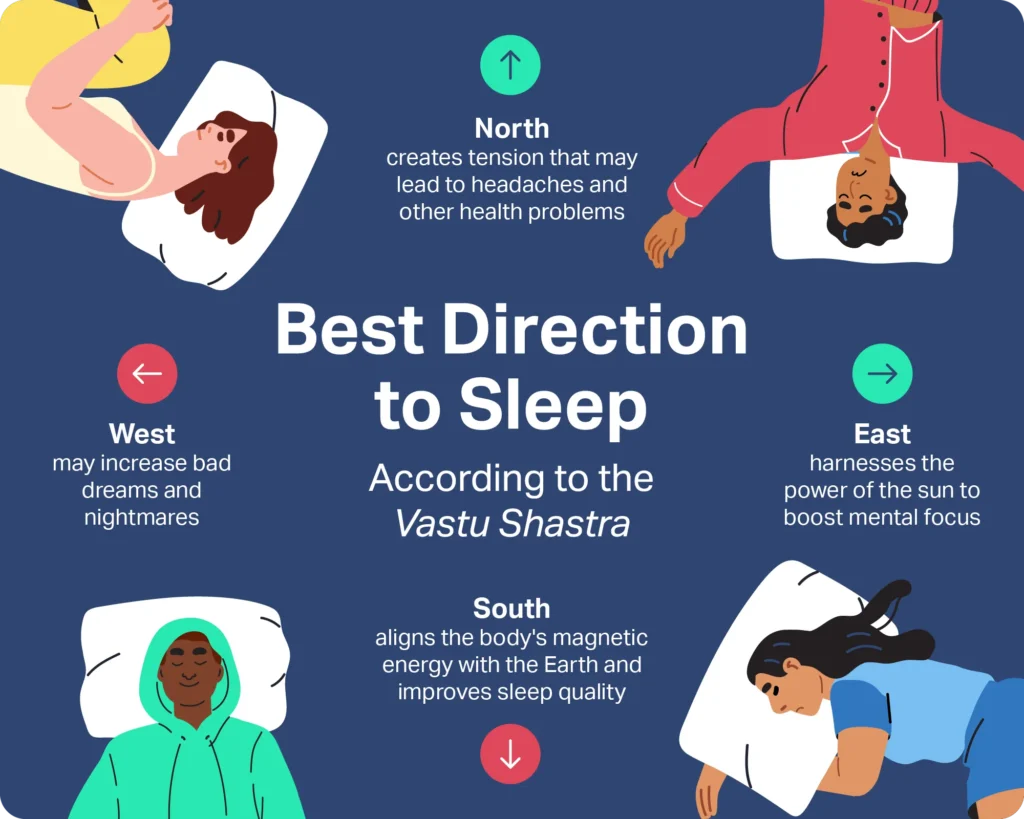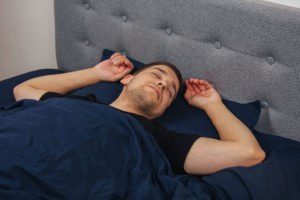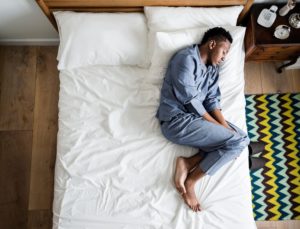When you buy through our links, we may earn a commission. Products or services may be offered by an affiliated entity. Learn more.
The Best Direction to Sleep In
- The ancient Indian tradition of Vastu Shastra recommends sleeping with your head pointing toward the east or south for better sleep and overall health.
- The principles of feng shui recommend aligning your head toward the north during sleep to harmonize your body with the Earth’s energy.
- Some studies suggest that a north-south sleeping orientation may improve sleep quality by aligning with Earth’s electromagnetic field.
Creating the ideal sleep environment often starts with the basics—dim lighting, calming wall colors, and cozy bedding. But according to Eastern medicine and spiritual traditions, there’s another factor that might influence your rest: the direction you sleep in. Below, we’ll explore what Vastu Shastra, feng shui, and Western science have to say about which way to face for the best night’s sleep, as well as how to figure out your ideal sleep setup.
Which Direction Is Best to Sleep In?
The idea that sleep direction might affect your rest stems from the belief that the human body is sensitive to the Earth’s magnetic field. A recent study found changes in brain wave activity when participants were exposed to manipulated electromagnetic fields , suggesting that our biology could respond to the planet’s natural energy. This has sparked curiosity across scientific and spiritual communities alike.
However, earlier research found no significant impact on sleep quality from magnetic exposure, so while the concept is intriguing, more evidence is needed to draw firm conclusions.
Still, if you’re curious about what the research and traditions have to say, let’s take a closer look.

According to Vastu Shastra: East or South
Vastu Shastra is an ancient Indian system of architecture that emphasizes designing spaces in alignment with natural forces. Rooted in Hindu philosophy, it treats buildings—and the people who live in them—as interconnected with the universe’s energy. A core idea is that, like the Earth, the human body has its own magnetic field, with the head representing the north pole and the feet the south.
According to Vastu Shastra, the ideal sleep direction is with your head pointing east and your feet west. This position is believed to encourage mental clarity, sharper memory, and increased vitality by aligning you with the rising sun—symbolic of growth, knowledge, and new beginnings.
A close second is sleeping with your head pointing south, which is thought to promote longevity, wealth, and better health. Facing south is said to harmonize your body’s magnetic energy with the Earth’s, while sleeping with your head pointing north—where similar poles repel—is discouraged, as it’s believed to contribute to disturbed sleep, headaches, or elevated blood pressure.
According to Feng Shui: North
Feng shui is an ancient Chinese practice focused on creating balance between individuals and their surrounding environment through the flow of energy, or chi . The layout of furniture, orientation of rooms, and even the direction you sleep in can all influence how energy circulates and supports your well-being.
In feng shui, sleeping with your head pointing north is considered the most harmonious position. This alignment is thought to mirror the natural flow of the Earth’s magnetic field, helping to promote calm, restorative sleep. When your body is in sync with this energy, it encourages the smooth circulation of chi throughout the night, which is believed to enhance both sleep quality and overall vitality.
According to Western Science: North-South
While Eastern philosophies like Vastu Shastra and Feng Shui have long emphasized the importance of sleep orientation, modern scientific research is beginning to explore this idea as well. A small (but growing) body of evidence suggests that the direction you sleep in may influence sleep quality, blood pressure, and brain activity—possibly due to the Earth’s electromagnetic field.
One study found that participants who slept in a north-south direction experienced improved sleep quality and lower blood pressure compared to those sleeping east-west. This research suggests that aligning the body with the Earth’s magnetic field may help maintain better sleep hygiene and overall well-being.
Another study reported that participants sleeping in a north-south position had longer sleep duration and increased deep sleep , while those in an east-west direction experienced shorter sleep and more disrupted brainwave activity during the night.
Interestingly, some animals like cattle and deer instinctively align themselves along a north-south axis while resting, hinting at a possible biological inclination to align with geomagnetic fields.
While more research is still needed, these early studies indicate that sleeping with your head pointing either north or south may be more beneficial than east-west orientations in terms of both sleep quality and cardiovascular health.
Note: These recommendations for either a north or south sleeping direction assume that you live in the Northern hemisphere. If you live in the Southern hemisphere, the opposite would apply.
Is Your Troubled Sleep a Health Risk?
A variety of issues can cause problems sleeping. Answer three questions to understand if it’s a concern you should worry about.
Does Sleeping Direction Really Matter?
Despite centuries of tradition in Eastern philosophies and some intriguing early studies in Western science, there’s still no definitive answer to whether your sleep direction truly affects your health.
That said, sleep is deeply personal, and what works for one person may not work for another. If you’ve noticed that you tend to sleep more soundly or wake up feeling more refreshed when facing a certain direction, that’s valuable information. Your own experience is worth listening to, especially if it leads to better rest.
In the absence of firm guidelines, it’s best to focus on creating an overall sleep environment that supports relaxation and consistency (see below for more). But if adjusting your sleep direction helps you rest easier, there’s no harm in aligning yourself accordingly.
How Do You Figure Out the Best Direction to Sleep?
If you’re curious whether the direction you sleep in affects your rest, you don’t need to overhaul your entire bedroom right away. Instead, try a simple experiment to see what works best for you. Here’s how to explore what direction might be best for your sleep:
- Determine your current sleep direction: Use a compass or compass app on your phone to find out which way your head is pointing when you lie down in bed.
- Make small, manageable adjustments: If possible, rotate your bed or adjust your sleeping position so your head faces a different cardinal direction (north, south, east, or west). If moving your bed isn’t practical, try repositioning your pillow.
- Stick with it for a few nights: Give yourself at least three to five nights in each direction to allow your body to adjust and notice any differences in how you sleep.
- Keep a sleep diary: Record how long it took you to fall asleep, how rested you felt in the morning, and any changes in how often you woke up during the night.
- Compare your results: After trying a few directions, look back at your notes. Did one orientation help you fall asleep faster or wake up feeling more refreshed?
- Go with what works: There’s no one-size-fits-all answer. If a certain sleep direction consistently feels better for you, that’s a good sign to stick with it.

How Should You Set Up Your Bedroom for Better Sleep?
Adjusting your sleep direction is just one of many ways to improve the quality of your rest. Whether or not it makes a difference for you, there are plenty of proven strategies that can support better sleep on a regular basis.
According to Vastu Shastra
In addition to sleep direction, Vastu Shastra offers several guidelines for creating a more harmonious and restful bedroom environment:
- Bed Placement: Position your bed so that the headboard rests against a solid wall, ideally on the south or east side of the room. Avoid placing the bed directly under a beam or in line with the bedroom door, as this is thought to disrupt energy flow.
- Room Location: The ideal location for the master bedroom is in the southwest corner of the home, which is believed to offer grounding and stability.
- Declutter Your Space: Keep your bedroom clean and clutter-free, especially under the bed. According to Vastu, clutter can block the flow of positive energy and contribute to stress or restlessness.
- Use Soothing Colors: Select a color scheme based on your personality. Vastu Shastra believes that each person has more or less of the natural elements, which are called “doshas”:
- Those with vata dosha (air) should use green and yellows.
- Those with pitta dosha (fire and water) should paint with blues and greens.
- Those with kapha dosha (earth and water) should select reds and violets.
According to Feng Shui
If you’re interested in other ways to improve your sleep and the design of your bedroom, you may want to consider some additional recommendations from feng shui.
- Position Your Bed With Purpose: Place your bed against a solid wall—not under a window—and ideally on the wall opposite your bedroom door. This “ command position ” allows you to see the door while not being directly in line with it, helping you feel safe and in control. If this isn’t possible, consider adding a mirror (not facing the bed) so you can still view the door without disturbing your sleep with excessive energy.
- Avoid the “Coffin Position”: Feng shui warns against sleeping with your feet pointed directly at the door, since it mimics the way a person’s corpse is carried out of a room when a person dies. Position your bed so your feet are not aligned with the doorway.
- Create Positive Energy Through Design: Feng shui says objects like curtains, artwork, and plants can capture negative energy, known as “sha chi,” and transform it into good chi. Plants in particular can add a calming energy to your bedroom and help relieve stress. For couples, feng shui suggests removing work-related items to maintain the bedroom as a space for connection and rest.
- Use Color With Intention: Feng shui associates specific colors with directions and desired energies—green in the east for growth, white or gray in the west for prosperity, red in the south for power, and black in the north for communication. Consider using these colors as accent tones in alignment with your bedroom’s layout and personal goals.
According to Western Science
Modern sleep research supports a variety of practical, evidence-based strategies to optimize your bedroom for better rest. These tips focus on reducing disruptions, regulating your body’s natural rhythms, and creating an environment conducive to deep, uninterrupted sleep:
- Keep Electronics Out of the Bedroom: Screens emit blue light, which can suppress melatonin production and delay sleep onset. Phones, tablets, TVs, and even notification sounds can interfere with your ability to fall and stay asleep. Keeping electronics out of the bedroom—or at least silencing them—helps your brain associate the space with rest, not stimulation.
- Make It Dark: Light—especially artificial light—can signal to your brain that it’s time to be awake. To keep your body’s circadian rhythm on track, use blackout curtains or a sleep mask to block out ambient light from outside or inside the home.
- Set the Right Temperature: Experts recommend keeping your bedroom between 65 to 68 degrees Fahrenheit (18 to 20 degrees Celsius). Your body naturally cools as it prepares for sleep, and a slightly cool room can help you fall asleep faster and stay comfortable throughout the night.
- Reduce Noise: Unexpected sounds can jolt you awake or keep you in lighter stages of sleep. Consider using earplugs, white noise machines, or calming sleep sounds to mask disruptive noises and promote deeper rest.

Still have questions? Ask our community!
Join our Sleep Care Community — a trusted hub of sleep health professionals, product specialists, and people just like you. Whether you need expert sleep advice for your insomnia or you’re searching for the perfect mattress, we’ve got you covered. Get personalized guidance from the experts who know sleep best.
References
7 Sources
-
Wang, C. X., Hilburn, I. A., Wu, D. A., Mizuhara, Y., Cousté, C. P., Abrahams, J., Bernstein, S. E., Matani, A., Shimojo, S., & Kirschvink, J. L. (2019). Transduction of the geomagnetic field as evidenced from alpha-band activity in the human brain. eNeuro, 6(2), ENEURO.0483-18.2019.
https://pubmed.ncbi.nlm.nih.gov/31028046/ -
Tworoger, S. S., Davis, S., Emerson, S. S., Mirick, D. K., Lentz, M. J., & McTiernan, A. (2004). Effect of a nighttime magnetic field exposure on sleep patterns in young women. American Journal of Epidemiology, 160(3), 224–229.
https://pubmed.ncbi.nlm.nih.gov/15257995/ -
Bonaiuto, M., Bilotta, E., & Stolfa, A. (2010). “Feng shui” and environmental psychology: A critical comparison. Journal of Architectural and Planning Research, 27(1), 23-34.
http://www.jstor.org/stable/43030890 -
S. Mohamad Moosavi, Mahshid Ahmadi, Javad Setareh, Mani B.Monajemi. The Relationship between Quality of Sleep and Geographical Directions during Sleeping Process. International Journal of Indian Psychology. 2015;2(4). doi:https://doi.org/10.25215/0204.038
https://ijip.in/wp-content/uploads/2020/05/B00335V2I42015.pdf -
Hekmatmanesh, A., Banaei, M., Sadeghniiat-Haghighi, K., & Najafi, A. (2019). Bedroom design orientation and sleep electroencephalography signals. Sleep Medicine, 6(1), 33-37.
https://www.actamedicainternational.com/article.asp?aulast=Hekmatmanesh;epage=37;issn=2349-0578;issue=1;spage=33;volume=6;year=2019 -
Begall, S., Cerveny, J., Neef, J., Vojtech, O., & Burda, H. (2008). Magnetic alignment in grazing and resting cattle and deer. Proceedings of the National Academy of Sciences of the United States of America, 105(36), 13451–13455.
https://pubmed.ncbi.nlm.nih.gov/18725629/ -
Margolies, J. (2020, September 29). Feng shui lessons from a design master who has your back. The New York Times.
https://www.nytimes.com/2020/09/29/style/fengshui-interior-design-lesson.html















